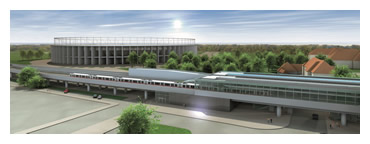Discover more about the topics and technologies that were discussed at the 2019 conference, via a series of exclusive interviews with a selection of our expert speakers.
 With the number of public transport users set to rise, Silvia Bernkopf, business development, dynamic transportation systems, Center for Mobility Systems, AIT Austrian Institute of Technology GmbH, discusses how pedestrian simulation can prevent overcrowding in transportation
With the number of public transport users set to rise, Silvia Bernkopf, business development, dynamic transportation systems, Center for Mobility Systems, AIT Austrian Institute of Technology GmbH, discusses how pedestrian simulation can prevent overcrowding in transportation
What is your presentation about?
As the number of public transport users increases, the risk of overcrowding is becoming a major challenge that needs to be addressed. Big crowds must be managed in infrastructures with limited space in a very short time. The analysis and optimization of pedestrian flows through simulations and investigations in virtual environments minimizes risks and increases efficiency and comfort. My presentation will highlight the capabilities of AIT’s planning tools from small-scale measures to considerable actions. Successful projects with applications in public transport, major events, city districts and tourist hot spots will demonstrate the benefits and positive impact.
What causes overcrowding in public transport infrastructures?
Overcrowding in public transport infrastructures can be caused by peaks, for example during rush hour or on the occasion of major events. Another difficulty that many public transport operators are confronted with is the steadily increasing number of passengers while the capacity of the infrastructure is static, or can only be increased through substantial investments.
How can overcrowding be avoided?
When we are talking about new transport infrastructure, thorough planning is key. By using pedestrian simulation tools, plans can be validated, and various scenarios of usage and layout can be analyzed before construction starts.
For an existing infrastructure, the challenge is to optimize what is already there. Even here, the use of simulation tools is highly effective, which enables users to test various scenarios, and not only evaluate the impact of small changes in the layout, but also indicate if evacuation times can still be maintained.
How can pedestrian simulation be made accurate enough? Aren’t people too unpredictable to get an accurate simulation?
This question was exactly the reason why we started to develop our own simulation tool more than 10 years ago. Commercially available simulation software is usually like a black box: the simulation methods are not clear or reproducible.
Therefore, we built a multidisciplinary team including mathematicians and engineers as well as psychologists, and have developed simulation tools that allow tailor-made analysis for different kinds of questions. Based on extensive literature research and enriched with a lot of real-world data, we have developed algorithms that reproduce human behavior convincingly well. In addition, in every single project we aim to include different data sources to calibrate the model for the specific question.
What successful projects provide a good example of the results of pedestrian simulation tools?
 We are proud to have already concluded a wide range of successful simulation projects. An example to be pointed out particularly is our collaboration with Wiener Linien, the Viennese public transport operator, on UEFA 2008, when a new metro station was built close to the stadium. The challenge was to develop a safe way to transport the huge numbers of passengers that would arrive at the station at the same time after the soccer matches.
We are proud to have already concluded a wide range of successful simulation projects. An example to be pointed out particularly is our collaboration with Wiener Linien, the Viennese public transport operator, on UEFA 2008, when a new metro station was built close to the stadium. The challenge was to develop a safe way to transport the huge numbers of passengers that would arrive at the station at the same time after the soccer matches.
We performed simulations in the planning process to support decision making regarding the layout of the station; at the same time we developed a real-time crowd management system to regulate the passenger flow into the station. We created a highly efficient and safe solution that at the same time offers an increased level of comfort for passengers. During UEFA 2008 it proved to be a valid and successful solution, and after more than 10 years it is still in operation whenever there are sports events, concerts and the like. This is a perfect example of how simulation tools can prevent overcrowding.
Don’t miss Silvia Bernkopf, business development, dynamic transportation systems, Center for Mobility Systems, AIT Austrian Institute of Technology GmbH give her presentation titled Preventing overcrowding – pedestrian simulation in virtual environments on Wednesday, December 11 at 09:00hrs as part of Stream 7: Quantum Effects Through Big & Small Changes. See the full conference program here. Register for your conference pass here.